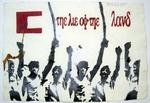AfterShock
dal 13/7/2007 al 1/9/2007
Segnalato da
Sainsbury Centrer for Visual Arts
13/7/2007
AfterShock
Sainsbury Centre for Visual Arts, Norwich
Conflict, Violence and Resolution in Contemporary Art

Conflict, Violence and Resolution in Contemporary Art
curated by Yasmin Canvin
AfterShock, a major new contemporary art exhibition, opens at the Sainsbury Centre for Visual Arts, Norwich on Saturday 14 July and runs until Sunday 2 September. The exhibition features sixteen international artists, six of whom are from India and one who is from Pakistan. The Guest Curator is Yasmin Canvin (born Zahir). Her family originally came from India and was caught up in the cross-border population movements, with disastrous consequences, during the 1947 partition of India and Pakistan. AfterShock is the Sainsbury Centre's contribution to Contemporary Art Norwich 2007, a city-wide celebration of international contemporary visuals arts from 14 July to 31 August. AfterShock was initially inspired by Indian artists‚ responses to religious intolerance, riots, terrorism and the on-going nuclear stand-off with Pakistan. The exhibition has been developed to include work from artists from across the world, who use a variety of techniques to explore the images of political and social violence that confront us everyday in the media.
Yasmin Canvin, guest curator, brings her family experience to the exhibition. Her father was seven years old in 1947. A Muslim family, they were living in what became the Indian section of Punjab. Yasmin's grandfather decided to sell up and move to Pakistan by ship, arriving safely with his family in Karachi. His brothers and their families took the cheaper and quicker option and travelled by train. All of them were killed en route.
"Curating Aftershock has been a great professional and private journey for me. I am a granddaughter of the partition and grew up in the Midlands where I was bullied for being 'different'. My career in the museum world has enabled me to explore cultural diversity and our responses to international contemporary art. It has been a privilege to collaborate with the Aftershock artists and present their work to a UK audience." - Yasmin Canvin
The artists in AfterShock provide differing personal responses to images of violence.
Amar Kanwar's film, A Season Outside, is a very personal meditation on violence and non-violence, focusing on the daily theatrical military 'show' by Indian and Pakistani border guards at the Wagah-Atari border in Punjab. Alia Hassan-Khan also uses film, and spent a year working in Lahore considering the imagery of security. Her film Kidnapped - homage to Karachi is viewed from the perspective of the victim lying in the back of a car. The paintings by Atul Dodiya and the films by Gigi Scaria both look at the life of Mahatma Ghandi and the way in which his influence is felt and remembered in India today.
Jitish Kallat's The Lie of the Land reworks familiar images - for those living in India - the well planned politician‚s photo opportunity, the rioting and the injured being stretchered away. Kallat's images are "blown" splattered and interrupted by red masses and text, creating a unique effect by blowing the work with a vacuum cleaner running in reverse whilst the images are drying. Jitish Kallat leaves the viewer to ponder the way that the media condition our response to violence.
Shilpa Gupta's work Untitled shows seven life size images of herself in camouflage which can be manipulated by the viewer. Since the "War on Terror" wearing camouflage, the clothing of conflict, has become increasingly popular in India - "terror chic"?
T. V. Santhosh's three paintings in the exhibition Another Taxi, Peace Protest and Fear, Nation and False Promise seduce the viewer with colour and invite them to think how the media reshapes and constructs our understanding of current events.
"The artists in AfterShock have found their own strategies for depicting violence and suffering without shocking. Through video, photography and images taken from the media, they give us the voice of the individual, producing moving personal responses to the conflict and violence they have experienced, either directly or indirectly. Together, the artists show us alternative narratives, arguing that the truth is not in any single image but somewhere in between" - Yasmin Canvin.
Sainsbury Centre for Visual Arts
University of East Anglia - Norwich



